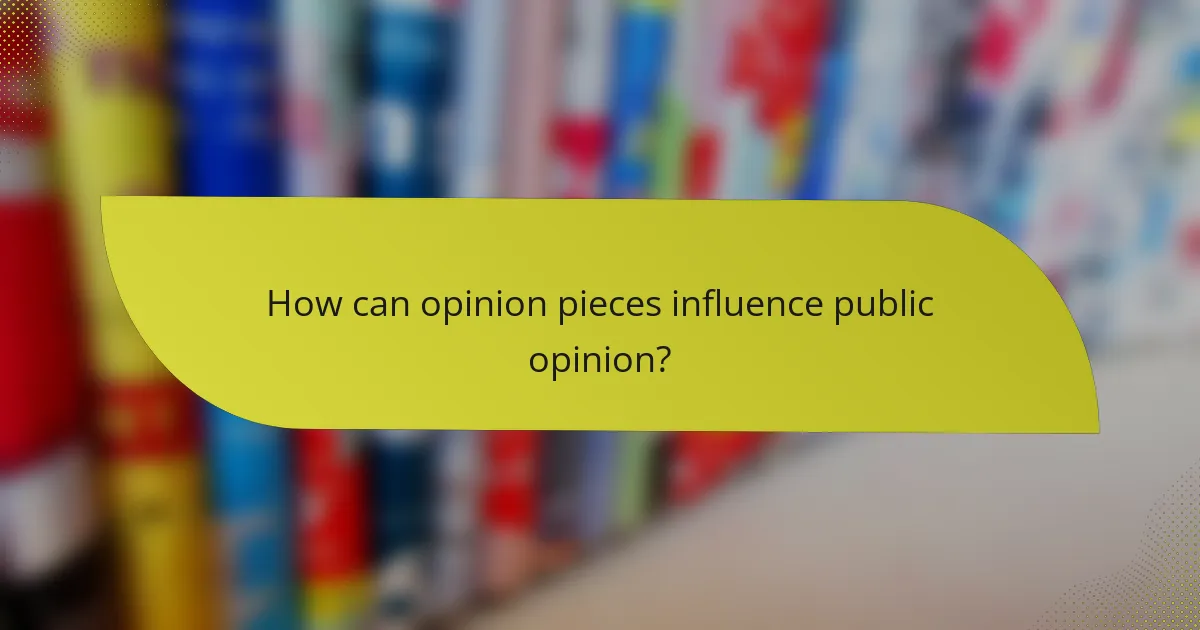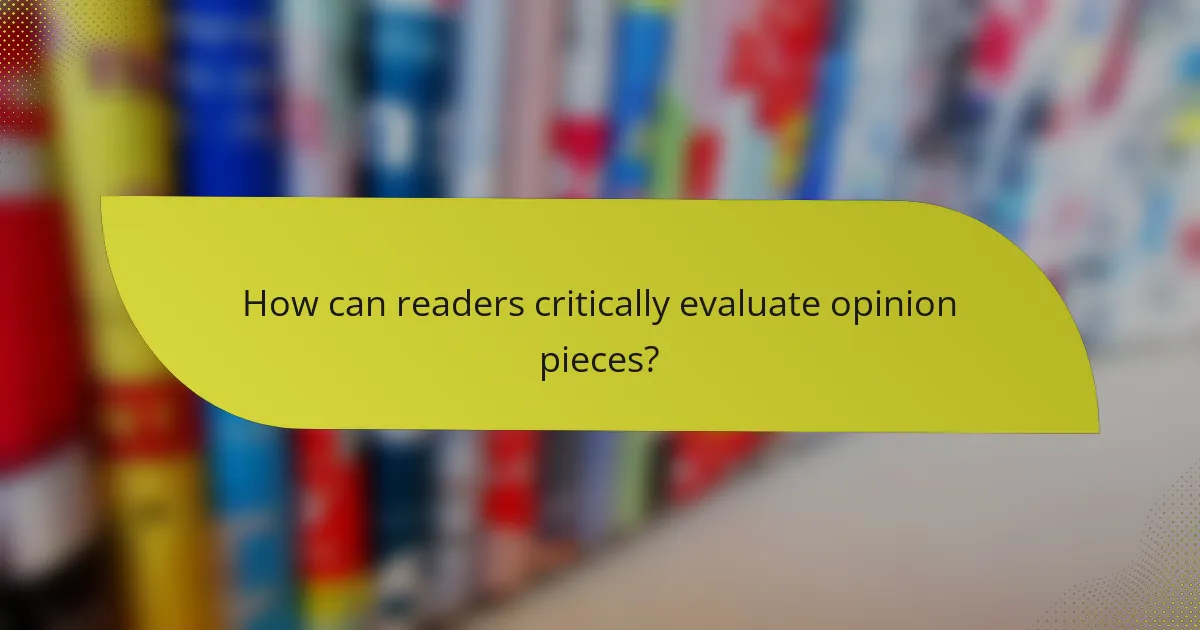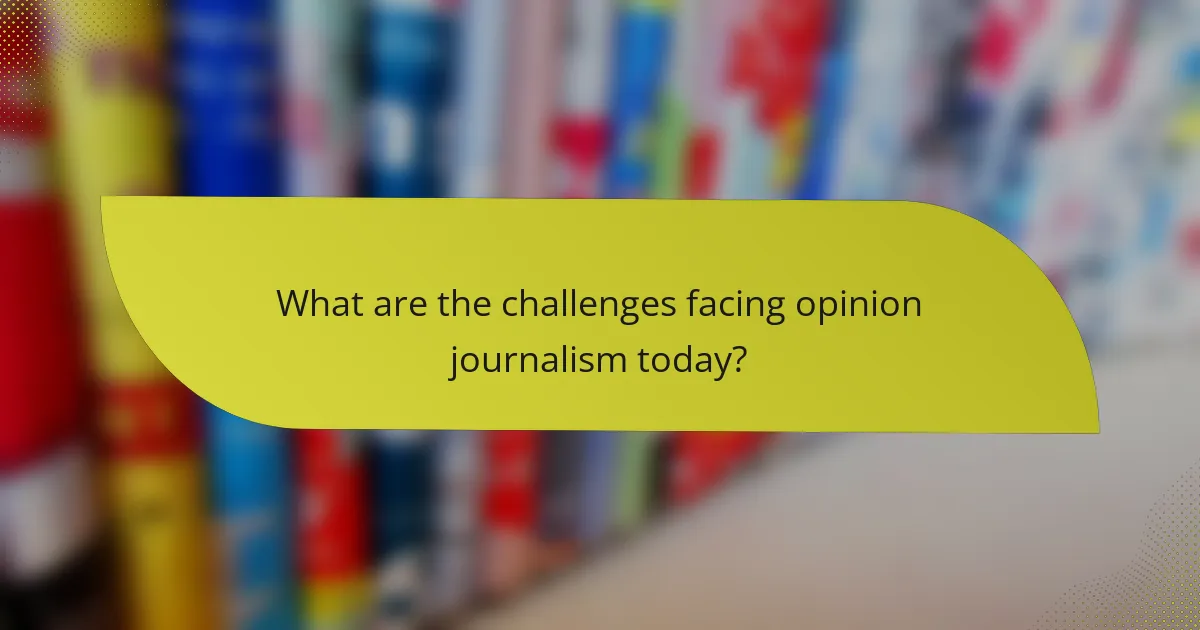Opinion pieces are essential for promoting news diversity, as they introduce a range of perspectives and stimulate discussions on significant topics. By engaging readers with differing viewpoints, these articles contribute to a more informed public and enrich the overall media environment.

How do opinion pieces enhance news diversity in the United States?
Opinion pieces play a crucial role in enhancing news diversity by presenting a variety of viewpoints and fostering dialogue on important issues. They allow readers to engage with differing perspectives, which can lead to a more informed public and a richer media landscape.
Encouraging diverse perspectives
Opinion pieces encourage diverse perspectives by providing a platform for writers from various backgrounds to share their insights. This diversity of thought can challenge dominant narratives and introduce new ideas, enriching the overall discourse in the media. For instance, a local newspaper might feature opinion articles from community leaders, activists, and academics, each offering unique viewpoints on regional issues.
By including a range of opinions, publications can cater to a broader audience, ensuring that different segments of society feel represented. This inclusivity can help to bridge divides and foster understanding among readers with differing beliefs.
Highlighting underrepresented voices
Opinion pieces are essential for highlighting underrepresented voices that may not receive attention in mainstream news coverage. These articles can spotlight issues affecting marginalized communities, such as racial minorities, [censured] individuals, or economically disadvantaged groups. By amplifying these voices, opinion pieces can raise awareness and prompt action on critical social issues.
Publications that prioritize diverse opinion content can help to rectify imbalances in representation, ensuring that all community members have a chance to contribute to the conversation. This can lead to more equitable media coverage and a deeper understanding of societal challenges.
Fostering public discourse
Opinion pieces foster public discourse by inviting readers to engage with complex topics and share their thoughts. They often encourage discussions in the comments section or on social media, creating a space for dialogue and debate. This interaction can help to demystify contentious issues and promote critical thinking among readers.
To maximize the impact of opinion pieces, publications should encourage respectful exchanges and provide guidelines for constructive dialogue. This approach can help cultivate a culture of open discussion, where differing opinions are valued and considered, ultimately strengthening democratic engagement in society.

What are the key characteristics of effective opinion pieces?
Effective opinion pieces are characterized by a clear stance, well-supported arguments, and an engaging writing style. These elements work together to persuade readers and contribute to a diverse media landscape.
Clear argumentation
Clear argumentation is essential for an opinion piece to resonate with readers. The writer should present a specific viewpoint and outline the reasoning behind it in a straightforward manner. This clarity helps readers understand the author’s position and encourages them to engage with the content.
To achieve clear argumentation, start with a strong thesis statement that encapsulates your main point. Follow this with logically structured paragraphs that build upon your argument, ensuring each point connects back to the central thesis.
Strong evidence and examples
Strong evidence and examples bolster the credibility of an opinion piece. Writers should support their arguments with data, expert opinions, or real-world examples that illustrate their points effectively. This not only strengthens the argument but also helps readers relate to the topic.
Incorporating a mix of qualitative and quantitative evidence can enhance the piece. For instance, citing statistics alongside personal anecdotes can create a more compelling narrative. Aim to use reputable sources to establish trust and authority in your claims.
Engaging writing style
An engaging writing style captures the reader’s attention and keeps them interested throughout the piece. This involves using a conversational tone, varied sentence structures, and vivid language that evokes imagery or emotion. A strong opening and closing can also significantly impact reader engagement.
To improve your writing style, consider employing rhetorical questions or anecdotes that resonate with your audience. Additionally, using short paragraphs and bullet points can make complex ideas more digestible, enhancing overall readability.

How can opinion pieces influence public opinion?
Opinion pieces can significantly shape public opinion by presenting arguments and perspectives that resonate with readers. They often provide a platform for diverse voices, encouraging critical thinking and dialogue on important issues.
Shaping perceptions on social issues
Opinion pieces play a crucial role in shaping perceptions on social issues by highlighting different viewpoints and experiences. For instance, an article discussing racial inequality can bring awareness to systemic problems and encourage readers to consider the implications of these issues in their own lives.
By framing social issues in relatable terms, opinion pieces can challenge stereotypes and foster empathy. This can lead to a more informed public that is willing to engage in discussions and advocate for change.
Driving engagement with current events
Opinion pieces drive engagement with current events by offering unique insights and interpretations that go beyond standard news reporting. They often provoke thought and discussion, prompting readers to reflect on their own beliefs and the broader societal context.
For example, an opinion article about a recent political decision can spark debates on social media, encouraging readers to share their views and engage with others. This interaction can amplify the reach of the original piece and foster a community of informed citizens.
Mobilizing community action
Opinion pieces can mobilize community action by inspiring readers to take a stand on issues that matter to them. When writers share personal stories or compelling arguments, they can motivate individuals to participate in local initiatives or advocacy efforts.
For instance, an opinion piece calling for environmental reforms may encourage readers to join local clean-up events or support sustainable practices. By connecting personal narratives to broader movements, these articles can create a sense of urgency and collective responsibility among community members.

What role do editorial guidelines play in opinion pieces?
Editorial guidelines are crucial in shaping opinion pieces by ensuring that they adhere to standards of credibility, accuracy, and ethical considerations. These guidelines help maintain the integrity of the publication while allowing diverse viewpoints to be expressed responsibly.
Ensuring credibility and accuracy
Credibility in opinion pieces is established through rigorous fact-checking and sourcing. Writers are encouraged to support their arguments with reliable data and references, which enhances the trustworthiness of their opinions. For instance, citing studies or expert opinions can bolster claims made in the piece.
Accuracy is equally important; misleading information can damage both the writer’s reputation and the publication’s credibility. Editorial guidelines often require that opinion pieces undergo a review process to verify facts before publication, ensuring that readers receive well-informed perspectives.
Maintaining ethical standards
Ethical standards in opinion writing focus on transparency and fairness. Writers should disclose any potential conflicts of interest and strive to represent opposing viewpoints fairly, allowing readers to understand different perspectives. This practice fosters a balanced discourse and enhances the overall quality of the discussion.
Additionally, editorial guidelines often emphasize the importance of avoiding hate speech and discriminatory language. By adhering to these ethical standards, publications can promote a respectful dialogue while encouraging diverse opinions, ultimately enriching the media landscape.

How can readers critically evaluate opinion pieces?
Readers can critically evaluate opinion pieces by examining the underlying biases, assessing the credibility of the sources, and analyzing the structure of the arguments presented. This process helps in forming a well-rounded understanding of the opinions expressed and their implications.
Identifying bias and perspective
To identify bias in opinion pieces, consider the author’s background, affiliations, and the language used. Look for emotionally charged words or one-sided arguments that may indicate a particular perspective. Understanding the context in which the opinion is presented can also reveal potential biases.
For example, an opinion piece written by a political activist may lean towards a specific ideology, while one authored by a journalist may strive for neutrality. Recognizing these influences is crucial for a balanced viewpoint.
Assessing source credibility
Evaluating the credibility of sources cited in an opinion piece is essential for understanding its reliability. Check the author’s qualifications, the reputation of the publication, and the accuracy of the data presented. Reliable sources typically have a track record of factual reporting and transparency.
For instance, a piece referencing studies from well-known research institutions or established news outlets is generally more credible than one relying on anonymous sources or fringe websites. Always cross-reference claims with reputable sources.
Analyzing argument structure
Analyzing the structure of arguments in opinion pieces involves examining the logic and coherence of the claims made. Look for clear premises that lead to a conclusion, and assess whether the arguments are supported by evidence. A well-structured argument should be easy to follow and logically sound.
Consider using a simple checklist: Are the claims backed by data? Do the arguments address counterpoints? Is there a clear connection between the evidence and the conclusions drawn? This approach can help in discerning the strength of the opinion presented.

What are the challenges facing opinion journalism today?
Opinion journalism faces several challenges, including the rise of misinformation and the need to maintain audience trust. These issues complicate the role of opinion pieces in providing diverse perspectives while ensuring credibility and accuracy.
Combatting misinformation
Misinformation poses a significant threat to opinion journalism, as false narratives can easily spread through social media and other platforms. Journalists must fact-check their sources rigorously and provide clear citations to support their arguments, which helps to counteract misleading claims.
To combat misinformation effectively, opinion writers should focus on transparency and clarity. This includes explaining the reasoning behind their viewpoints and addressing potential counterarguments. Engaging with credible experts and using data from reliable sources can also enhance the integrity of opinion pieces.
Maintaining audience trust
Building and maintaining audience trust is crucial for opinion journalism, especially in an era of skepticism towards media. Opinion writers should strive for honesty and integrity in their analyses, avoiding sensationalism and bias to foster a loyal readership.
One effective strategy is to openly acknowledge potential conflicts of interest and to provide a balanced view of contentious issues. Regularly engaging with the audience through comments or social media can also help to reinforce trust, as it shows that writers value their readers’ perspectives and feedback.
